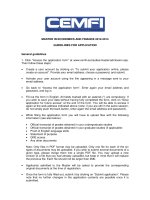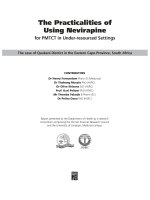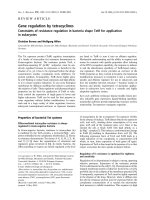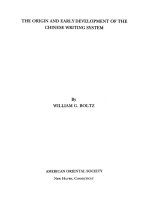nvestigating the influences of tidal inundation and surface elevation on the establishment and early development of mangroves for application in understanding mangrove rehabilitation techniques 1 3
Bạn đang xem bản rút gọn của tài liệu. Xem và tải ngay bản đầy đủ của tài liệu tại đây (536.23 KB, 16 trang )
Chapter 2 – Literature Review
2.1. The roots of restoration science
The concept of restoration was considered as early as the 19th Century, and the first
well-known attempt to restore land began when Aldo Leopold launched the Curtis
Prairie project in Wisconsin in 1934 (Palmer et al., 2014). Despite those early efforts,
it was only in the 1980s that ecological restoration entered mainstream scientific
thought, evident by the founding of the Society for Ecological Restoration in 1987
(SER, 2015). Restoration ecology is a rapidly growing science, with an exponential
growth in research publications appearing across a broad array of scientific journals
(Palmer et al., 2014). While restoration ecology is largely an applied science carried
out in the field, the theoretical basis of restoration ecology is firmly rooted in classical
ecology.
To understand the potential for the restoration of an ecosystem, there exists strong
emphasis on understanding (i) what factors enhance the restoration of biodiversity
(Rodrigues et al., 2011), (ii) the roles of physical habitat heterogeneity in the rate and
degree of recovery (Holl et al., 2013), (iii) the use of resilience theory (state changes
and feedbacks) (Suding et al., 2004), (iv) spatial ecology (i.e. ecosystems connectivity
in relation to dispersal dynamics and metapopulation theory) and (v) the landscape
context encompassing the restoration site (Reynolds et al., 2013).
As the concept of ecosystem services gains acceptance by policy makers, restoration
managers and funders have shifted the focus of restoration to a pre-disturbance
condition, to a state which can provide ecosystem services (Benayas et al., 2009). This
translates into a change in the type of science demanded from restoration ecologists
and is reflected in the scientific focus of studies on testing ecological theories
8
underlying restoration, aiming to understand the functional roles of species in
supporting ecosystem processes or products of value to humans (Montoya et al., 2012).
2.2. The restoration of coastal wetlands
Anthropogenic changes in rivers, estuaries and coastal landscapes, accumulated over
time, mean that few coastal wetlands remain untouched or have retained complete
historical ecosystem functions (Palmer et al., 2014). One of the best examples is the
management of river flows where dams have replaced natural hydrological pulsing of
water with large and, for most part, uncontrollable flooding events. Similar smaller
scale yet cumulative effects that affect wetlands have been caused by mining waste,
land use change and urbanisation (Simenstad et al., 2006). Restoration initiatives have
been on the rise as society attempts to reverse ecosystem degradation for the
improvement of future conditions over current state (Reed et al., 1997; Purcell et al.,
2002; Milano et al., 2007).
2.2.1 The evolution of coastal wetlands restoration
Early coastal wetland restoration efforts focused on mitigating problems in isolation,
without consideration for the connectivity of the ecosystem to the larger landscape
(Simenstad et al., 2006).
Recent restoration projects have evolved to include a scale of planning, design and
implementation to achieve functional, self-sustaining restoration through the
understanding and reinstating of fundamental ecosystem processes on a landscape
scale. The approach advocates setting clear and realistic restoration goals, monitoring
restoration responses and adopting a precautionary, adaptive approach (Simenstad et
al., 2006). A core guiding principle is that removal of barriers will direct the
9
restoration of physical, geochemical, ecological and other ecosystem processes
towards a more natural state (Simenstad et al., 2006). The progression of ecosystem
recovery over time, referred to as “restoration trajectories” (Hobbs & Norton, 1996),
has been characterised as a pathway of ecosystem redevelopment toward a less
compromised, or even the attainment of a fully functioning system that proves
comparable to “target” reference sites (Figure 2.1; Aronson et al., 1993). Yet, there
exists wide variation in response patterns and rates of such trajectories due to
variability in restoration approaches, the types and levels of stressors, antecedent
conditions, and changes in the landscape setting (Hobbs & Harris, 2001).
Figure 2.1: A traditional view of restoration options for a degraded system, illustrating the idea
that the system may proceed along different trajectories and that the goal of restoration is to
guide the trajectory towards some desired state. Source: Hobbs & Norton, 1996.
10
2.2.2 Approaches in coastal wetland restoration
There are three basic approaches to ecosystem recovery: passive, active, and creation
(Simenstad et al., 2006). In passive approaches, barriers to natural recovery are
removed to allow the reinstatement of pre-degraded ecosystem processes. No
additional actions are required in facilitating restoration. For example, studies
evaluating ecosystem responses to removal or breaching of levees surrounding a
former wetland often report how flooding events reinstate ecosystem processes such as
sedimentation rate (Simenstad & Warren, 2002). Active approaches are achieved
through planned actions that specifically re-create wetland structure and processes. It
usually involves the removal of barriers hampering natural recovery and active
management of ecosystem processes (Simenstad et al., 2006). For example, reestablishing tidal hydrology in a drained and levelled estuarine wetland might involve
both digging channels to encourage tidal channel development and plantings to
promote re-colonisation of native marsh vegetation. Creation is the establishment of
wetlands where none previously existed (Simenstad et al., 2006). The restoration
concept and design will be referenced from wetlands elsewhere but such efforts
usually achieve the creation of structure rather than the natural process of ecosystem
function.
2.3 Adopting the Ecological Mangrove Rehabilitation (EMR) approach
The EMR paradigm largely mirror the active approach used in the restoration of
coastal ecosystems (Section 2.2.2). EMR was first published as a presentation abstract
at the 1998 World Aquaculture Society meeting in Las Vegas, Nevada, USA by Lewis
and Marshall (1998). It comprised of five steps, but has since been tested and refined
11
through application to multiple rehabilitation projects (Lewis, 2005; Brown & Lewis,
2006) before a publication comprising of six steps was achieved (Lewis, 2009).
The approach seeks to facilitate natural regeneration to construct and rehabilitate selfsustaining mangrove ecosystems that are valuable to both humans and nature (Mitsch
& Jørgensen, 2004; Lewis & Brown, 2014). EMR is designed to provide a logical
sequence of tasks that are likely to succeed in re-establishing a biodiverse ecologically
functioning mangrove ecosystem with vegetation structure similar to that of a natural
reference mangrove forest, has tidal creeks connected to upland freshwater systems
and is able to support a diverse faunal community (Lewis & Brown, 2014). The site is
also designed to persist over time without a significant amount of human intervention.
EMR is advantageous in three ways – (i) rehabilitate ecosystems substantially
degraded by humans, (ii) develop new sustainable ecosystems with both human and
ecological value and (iii) achieve (i) and (ii) in a cost-effective manner (Lewis, 2005).
2.3.1 The 6-step EMR approach
As summarised in Figure 2.2, the approach comprises of six critical steps, with focus
on (i) pre-rehabilitation planning (Steps 1 – 3) and (ii) the subsequent design and
implementation of actual rehabilitation works (Steps 4 – 6). Chosen sites must
encompass high potential for successful rehabilitation into a self-sustainable mangrove
ecosystem. Some essential characteristics for consideration include soil texture,
sediment budget, hydrodynamic influences (wave and wind action), hydrology, land
topography and landscape connectivity to other mangrove patches to facilitate
propagule exchange.
12
Figure 2.2: The 6-step EMR approach (Lewis & Brown, 2014).
EMR prioritises hydrologic restoration without human-mediated planting as the
distributions of mangroves and subsequent development are influenced mostly by
appropriate surface elevations and thus, inundation durations. When the pre-requisites
of appropriate surface elevations, inundation durations and propagule availability are
met, rehabilitation sites can undergo secondary succession quickly and with minimal
human intervention (Cintrón-Molero, 1992; Stevenson, 1997; Zedler 2000; Bosire et
al., 2003). Establishment of naturally recruited mangrove propagules will thus be the
dominant event driving reforestation of the rehabilitation site.
Surface elevations in abandoned aquaculture ponds are generally modified to be
unnaturally low to ensure perpetual flooding. As mangroves can only establish and
develop at suitable elevations, the introduction of fill material may be necessary to
raise the elevation to one suitable for mangrove recruitment and establishment.
13
Additionally, diking and its implication of prolonged flooding are stresses to
mangroves (Brockmeyer et al., 1996). Hence, tidal hydrology should be restored
through the removal or modification of obstructions to tidal connection (i.e. strategic
breaching of dike walls; Brown & Lewis, 2006; Dale et al., 2014; Lewis & Brown,
2014). To catalyse the establishment of mangroves, mature propagules are collected
from surrounding forests, and hand-broadcast on the rising tide (Lewis & Brown,
2014). The method is most advantageous because composition of the rehabilitated
mangroves will be similar to that of surrounding mangroves as the resultant mix of
established species is regulated by the composition of locally occurring species. Also,
incompatibility between site environmental conditions and biological tolerances of
mangrove species will be minimised as propagules will naturally establish at
appropriate surface elevations. This further prevents the conversion of inappropriate
habitats (e.g. mudflats, sand flats and seagrass beds), where elevation is commonly too
low and where the coast is overly exposed to mechanical wind stress and higher wave
action, into mono-specific plantations (Erftemeijer & Lewis, 1999; Samson & Rollan,
2008). An alternative or supplementary approach would be to plant locally-sourced
propagules and/or wildings (naturally occurring wild seedlings) and nursery-grown
seedlings/saplings. The caveat however, is to determine the appropriate area for such
plantings as species differ in their tidal and inundation ranges and soil type. Therefore,
any planting remains controversial and should only be attempted as a last resort
(Lewis, 2005).
14
2.4 The importance of surface elevation and inundation hydroperiod for
mangrove rehabilitation success
Numerous papers have discussed the science behind mangrove hydrodynamics
(Wolanski et al., 1992; Wolanski et al., 1993; Furukawa et al., 1997; Mazda et al.,
2007), with focus on tidal and freshwater flows and relationships between mangroves
and wave attenuation and sedimentation processes. Also, Kjerfve (1990) argued for the
importance of topography as micro-topography governs the distribution of mangroves,
with physical processes playing a dominant role in the formation and functional
maintenance of mangrove ecosystems. Surface elevations in mangroves, and its
inherent control on periods of inundation and drainage, are therefore critical
determinants of forest health. For example, hyper- and hypo-salinity resulting from
changes to rainfall and normal freshwater flows can kill mangroves (Cintrón et al.,
1978; Medina et al., 2001; Biber, 2006) and changes inundation regimes (frequency,
duration and depth) through global sea-level rise can stress (and kill) mangroves when
they are unable to adapt.
The knowledge of appropriate surface elevations and its influence on inundation can
be said to be one of the more important factors that determine the success of mangrove
rehabilitation (Lewis, 2005; Lewis, 2009; Gilman & Ellison, 2007; Friess et al., 2012).
Surface elevation, tidal frequency and amplitude determine inundation hydroperiod
(inundation frequency, duration and depth) whereby lower elevations are inundated
more frequently, for longer durations and to a greater depth. This relationship between
inundation hydroperiod and surface elevation, and the establishment and subsequent
survival of mangrove vegetation has been acknowledged by rehabilitation
practitioners, and is evident in their use of a comparable reference system to inform
rehabilitation planning and design, across both intertidal ecosystems such as tidal
15
marshes and mangroves (Sullivan, 2001; Vivian-Smith, 2001; Lewis & Brown, 2014).
Similarly, this relationship has been studied as evident in the large volume of journal
publications
focused
on
elucidating
the
relationship
between
surface
elevation/inundation regimes and mangroves establishment and physiological
development, and how this potentially translates into a control on the distribution of
mangrove species (McKee, 1995; Kitaya et al., 2002; Chen et al., 2005; He et al.,
2007; Chen et al., 2013).
Surface elevation and inundation durations work to impose differing impacts on
propagule establishment and early development in established seedlings. For example,
propagules subjected to consistent inundation will not be able to overcome their
inherent buoyancy to establish. Or, if rooting has occurred, mangroves may (i) be
exposed to prolonged inundation that thus comprises their development or (ii) not be
exposed to sufficient inundation and eventually die. Across the studies, there is
agreement that mangrove species differ in optimal thresholds to inundation periods,
and hence surface elevations. The general relationship between inundation durations
and physiological functioning of mangroves is that prolonged inundation (from low
surface elevations) impedes psychological processes such as aerobic respiration and
photosynthesis.
2.4.1 Field studies relating surface elevation and mangrove distributions
Studies have recognised distinct zones in mangrove forests, where different species are
observed to occupy different areas which are generally delimited from each other.
Watson (1928) first ascribed control of mangrove distributions to inundation
frequency. Through this field study, a Watson Classification was developed. The
classification comprises of five inundation classes, with details on the frequency of
16
inundation per month and dominant mangrove species for each respective class. For
example, mangroves in Inundation Class 1 will be flooded by all high tides, with an
inundation frequency of 56 – 62 times per month, and has no dominant vegetation
species (Watson, 1928; Table 2.1). Subsequently, de Haan (1931) expanded the
Watson Classification to include the effect of fresh water, hence increasing the number
of classes from five to eight. However, these are site-specific classifications and may
not prove relevant across all mangrove ecosystems. Thresholds of inundation period
and frequency will be influenced by location-specific factors. For example, studies
describing the inundation threshold of saltmarsh vegetation (Spartina spp.) suggested a
general tolerance of approximately 5800 – 7800 inundated hours per year (Friess et al.,
2012). Yet, site-specific conditions such as unusual tidal dynamics, frost damage stress
and water turbidity can act to change such thresholds (Hubbard & Partridge, 1981;
Christiansen & Møller, 1983)
Table 2.1 Watson inundation classification and the related Southeast Asian mangrove species.
Source: Watson, 1928.
Inundation
Flooded by
Flood frequency
admirality datum)
Class
Elevation (m above
Mangrove species
(times per month)
1
All high tides
Below 2.44
56 – 62
None
2
Medium high
2.44 – 3.35
45 – 59
Avicennia spp.,
tides
3
Normal high
Sonneratia
3.35 – 3.96
20 – 45
tides
4
Spring high
Rhizophora spp.,
Ceriops, Bruguiera
3.96 – 4.57
2 – 20
tides
Lumnitzera,
Bruguiera,
Acrostichum aureum
5
Equinoctial
4.57 and above
tides
Up to 2
Ceriops spp.,
Phoenix paludosa
17
It was only in the late 1960s that this control of mangrove distribution was expanded to
include the interaction of several environmental factors such as inundation frequency,
soil type and soil salinity (Macnae, 1966, 1968; Santistuk, 1983). Macnae (1968)
conducted a review on the zonation schemes that have been proposed for mangroves of
the Indo-West-Pacific region, and based it on inundation frequency, soil salinity and
generic name of the dominant trees. Mangroves were proposed to be considered under
three broad zonations (Santistuk, 1983). The fringing forests consist of trees or shrubs
which form a thin band facing open sea. The next zone is generally a well-developed
forest dominated by tall straight trees, principally members of the Rhizophoraceae.
Further landward is a transition forest which tends to be more floristically diverse than
the previous two, with its species composition depending on the type of forest
mangroves transition into (fresh water swamp, peat swamp, salt flat or dry land).
More recently, Crase et al. (2013) tested this theory statistically. The study quantified
the relationship between species’ dominance and hydroperiod (defined in the study as
the duration of inundation in a year), soil salinity and water salinity for three species –
Sonneratia alba, Rhizophora stylosa and Ceriops tagal. All models indicated that
hydroperiod was the key variable influencing mangrove distribution, followed by soil
salinity.
2.4.2 Experimental studies relating seedling responses to inundation
Multiple experimental studies under controlled systems and in the field have
established that mangroves exhibit species-specific responses on growth and survival
rates in response to varying inundation levels and durations. Growth and survival of
Avicennia germinans seedlings were compromised at intertidal positions where
inundation regimes were either greater or lesser than mean sea level (Ellison &
18
Farnsworth, 1993). Rhizophora mangle responded better to deeper inundation depths
and durations, characteristic of lower intertidal positions (Ellison & Farnsworth, 1993).
The relative growth rates of Bruguiera gymnorrhiza decreased as inundation duration
increased, while Kandelia candel exhibited no such reductions in response (Ye et al.,
2003). But with prolonged inundation, the capacity for photosynthetic light saturation
levels and photosynthesis was reduced for K. candel seedlings (Chen et al., 2005). B.
gymnorrhiza seedlings subjected to tidal inundation treatments had reduced seedling
height, diameter, leaf area, leaf biomass, stem biomass and root biomass relative to
controls (Krauss & Allen, 2003). However, tidal inundation unexpectedly enhanced
biomass attributes for Xylocarpus granatum seedlings, despite this species’ typical
natural preference for low inundation frequencies and durations (Allen et al., 2003). A
field survey on Avicennia marina established that elevation had a positive effect on
seedling growth – seedlings at lower elevations had less annual biomass accumulation
and population productivity (Lu et al., 2013). In the same study where a mesocosm
experiment was used to vary inundation durations and depth, both inundation duration
and depth exerted significant and negative effects on biomass accumulation,
photosynthetic rate, leaf electron transportation and water-use efficiency. The negative
effects of prolonged inundation were exacerbated by increasing inundation depth as
that resulted in complete canopy immersion of A. marina seedlings (Lu et al., 2013).
To simulate the effects of sea level rise, a 2.5-year experiment subjected R. mangle
seedlings to three relative tidal inundation regimes of increased sea level, no change
and decreased sea levels (Ellison & Farnsworth, 1997). While the experimental
simulation of “sea level rise” is questionable as it is a long-term process (decades) and
is a continuous, cumulative process that acts on mangroves development, the
experiment can be re-interpreted as seedlings were subjected to longer inundation
19
duration and depth in “increased sea level” treatments, with the opposite for
“decreased sea level” treatments. A comparison of the responses of seedlings
highlighted that seedlings in treatment with no change in sea level maintained 1 – 7%
fewer stomata per unit area, 6 – 12 % greater photosynthetic rates, and 3 – 23 %
greater absolute relative growth rates compared to seedlings in other treatments. Under
prolonged inundation durations, seedling growth eventually reduced (Ellison &
Farnsworth, 1997). This trend was registered in other mangrove species – K. candel
and B. gymnorrhiza demonstrated rapid growth over the first two months after sealevel rise simulations of 30 cm but were unable to maintain this rate beyond the initial
period (Ye et al., 2004).
In general, species-specific seedling physiological efficiency and growth potential are
reduced with increased inundation durations and depths beyond some optimum. Under
prolonged inundation, substratum oxygen concentrations will generally decrease, and
elicit an effect on mangroves primarily through their roots. Roots will exhibit lower
oxygen partial pressures in the root aerenchyma (McKee, 1996) and enter anaerobic
respiration for short durations, allowing some energy production to continue (Chen et
al., 2005). Such depressed development efficiency would translate towards low
rehabilitation success wherein recovery via secondary succession would be hampered
as seedlings would not survive for long.
2.4.3 Experimental studies relating propagule establishment to inundation
Unlike mangrove seedlings, inundation does not directly impact the growth and
survival of propagules through the reduction of photosynthetic capacity and growth
potential. Instead, optimum inundation durations achieved through optimum elevation
ranges have implications on the stranding and subsequent rooting of propagules, before
20
propagule viability is lost. Propagule buoyancy, period of obligate dispersal, rooting
time, and the action of tides and currents are primary factors determining dispersal and
establishment of mangroves and other water-dispersed species (Rabinowitz, 1978;
Foote & Kadlec, 1988; Schneider & Sharitz, 1988; Clarke & Myerscough, 1993;
Clarke, 1993; McGuinness, 1996; Delgado et al., 2001). Upon reaching a new habitat,
inundation frequency and duration become important factors in determining propagule
establishment success (Jiménez & Sauter 1991; Clarke & Myerscough, 1993, Balke et
al., 2011).
Two experimental settings, a field and mesocosm experiment, were employed in
studying propagule establishment in Laguncularia racemosa, Avicennia germinans
and Avicennia bicolour. Successful establishment in the field showed that both L.
racemosa and Avicennia spp. were optimised for establishment in the lower intertidal
zone compared to mud flats and upper intertidal zones (Delgado et al., 2001). Under
controlled mesocosm conditions, L. racemosa had successful establishment in
treatments with continuous-inundation and no-inundation whereas A. germinans
performed significantly better in treatments with no inundation and normal tidal
regime. Under the continuous-inundation treatment, L. racemosa showed significantly
higher establishment compared to A. germinans. L. racemosa propagules sank shortly
after their radicles protruded, favouring rooting under water, whereas highly buoyant
A. germinans propagules floated throughout the experiment and never established
(Delgado et al., 2001). Similarly, R. mangle propagules had difficulty establishing in
lower intertidal zones as tidal action regularly buoyed them away soil surface (McKee,
1995b). This again, emphasis species-specific variation in propagule physiology, and
its impacts on propagule establishment across different inundation regimes.
21
Flume studies and field observations by Balke et al. (2011) showed that establishment
of A. alba propagules require an inundation-free period that allows rapid development
of roots long enough to anchor the seedling and to withstand displacement by
inundation and wave action. Under a fixed tidal regime, probability of an inundationfree period occurring will increase with higher surface elevations. As most mangrove
propagules remain buoyant for long periods of time without sinking or losing viability,
this implies that mangrove establishment will require suitable elevations that optimise
the occurrence of such suitable inundation-free periods. Two additional thresholds that
seedlings must pass before successful establishment are related to hydrodynamics.
First, roots of seedling must grow to surpass a minimum length to withstand
hydrodynamic disturbances from waves and currents. Particularly when establishment
is occurring on exposed coasts (e.g. mudflats) with low elevations and higher exposure
to wave and wind action. Second, even longer roots are necessary for persistence
through high energy events that cause surface sediment mixing and/or erosion,
potentially inducing seedling dislodgement (Balke et al., 2011, Figure 2.1).
22
Figure 2.3: Schematic representation using an Avicennia alba propagule to illustrate the three
thresholds that have to be surpassed before establishment. (1) The propagule first has to
acquire a minimum root length during an inundation-free period to resistant against floating up
during tidal inundation. (2) Then, roots have to be long enough to resist hydrodynamics by
waves and currents. (3) Rooted seedling may still be dislodged via mixing or erosion of
surface sediments. Source: Balke et al., 2011.
23









